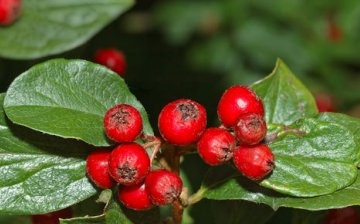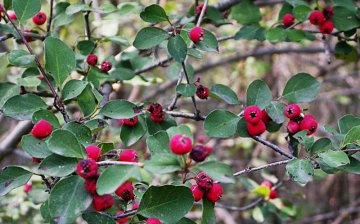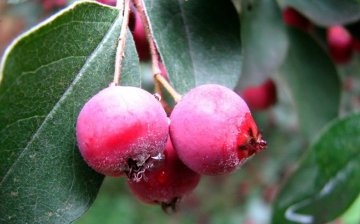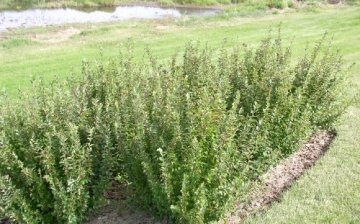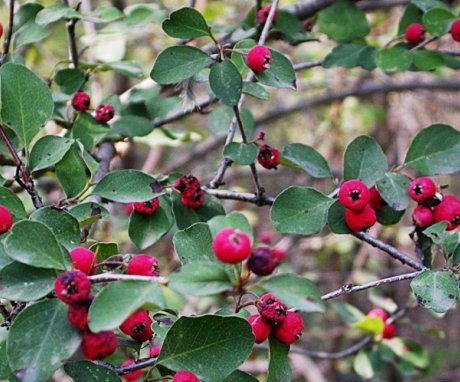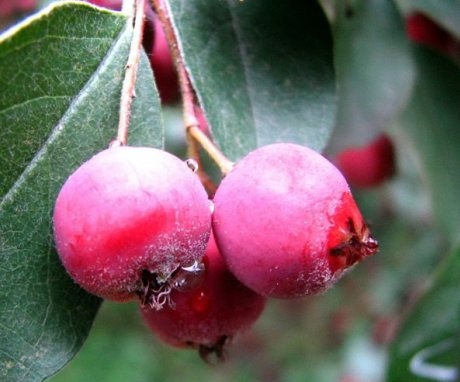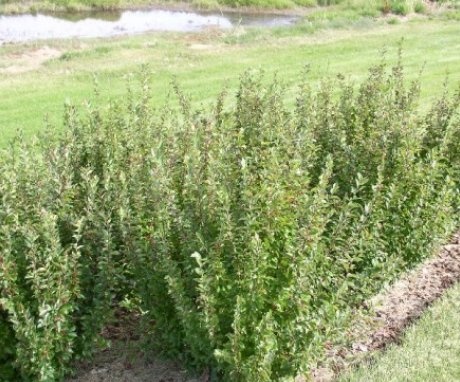Common cotoneaster: general information, care features, planting and reproduction
The cotoneaster is a shrub of the Pink family. The plant has many species, some of them can be deciduous, others are perennial. Usually, the cotoneaster is quite frost-resistant, which explains the popularity of this ornamental shrub in Russia. In Latin, the name of the cotoneaster sounds like Cotoneaster (translated as "looking like a quince").
Content:
- General information about the cotoneaster
- Reproduction of common cotoneaster
- Planting and caring for an ordinary cotoneaster
- Application of the cotoneaster
General information about the cotoneaster
Description of the common cotoneaster:
- Common cotoneaster, one of the species of this plant, is deciduous, reaches a height of no more than 2 meters.
- Leaves are ovoid and deep green at the top and gray pubescent at the bottom.
- The flowers are pale pink, collected in small inflorescences.
- The fruits resemble small red apples and last until September. Cotoneaster fruits often attract birds as food for them.
- This plant is very frost-resistant, takes root well in central Russia.
In its natural environment, the cotoneaster grows in some areas of Europe, Asia, North Africa. But the biggest variety of cotoneaster species was discovered in China. This plant was described as early as the 17th century. An ordinary cotoneaster fits perfectly for the decoration of a personal plot. He is unpretentious, handsome. It is good to use it as a hedge.
The cotoneaster has many benefits. This shrub has a dense beautiful crown, which is easy to give a well-groomed look, to depict even the most bizarre shape.
Gardeners can choose from a wide variety of species that they like. A creeping or erect cotoneaster, with leaves that turn orange or purple in autumn, with white or pink flowers.
In autumn, this plant does not lose its decorative appearance, but, on the contrary, acquire a certain charm due to the abundance of bright fruits. The cotoneaster tolerates both cold and heat well, as well as the unfavorable atmosphere of gas pollution in the city. It is very simple to rejuvenate this plant, it is enough to cut it at the root, and they live up to half a century.
Reproduction of common cotoneaster
There are several ways to breed a cotoneaster. You can propagate it by cuttings, seeds, layering, inoculation... Growing a cotoneaster from seeds is not easy. They have a fairly long dormant period. Therefore, they are sown from already in the fall.
Seeds should be watered regularly and provided with adequate heat and light, but protected from direct sunlight. When the first leaves appear, the plants can be planted in open ground. But you should not count on abundant shoots. Not all seeds sprout and the process of growing them is very laborious.
Breeding tips with cuttings:
- Propagation by cuttings is more popular than planting seeds. For this, only large, strong specimens are selected.
- In summer, green cuttings are used, in autumn they are woody.
- Wood cuttings in the fall need only be prepared, and not planted.And in the summer they are cut into 15-20 cm and planted in the same way as green ones.
- Cuttings are cut into pieces of 10-15 cm so that each has 2 internodes.
- Then the cut off stalk is placed in a pre-prepared solution to accelerate growth, and then planted.
- The top layer of soil must be covered with sand by 3-5 cm.
- Cuttings are deepened into well-moistened soil by about 5 cm and placed in a greenhouse or covered with glass.
- In autumn, those shoots that already have a well-developed root system can be planted in open ground. Do not forget to insulate young shoots for the winter.
The easiest way breeding cotoneaster is the vaccination. Cuttings prepared in advance are used as a scion. They are stored in a cool place, in an upright position, with one end in the sand. The sand will protect the cuttings from drying out, and the cold will stop their development.
The stock can be a young annual plant or a tall plant with a well-developed root.
In the second case, part of the root is separated and the scion is attached to its base. The graft and stock are fastened with plastic tape. It will be possible to remove it when they grow together tightly.
Planting and caring for an ordinary cotoneaster
Cotoneaster is an unpretentious plant. It does not require special knowledge in gardening and constant painstaking care. However, there are some conditions that must be met in order to create a truly beautiful garden:
- The landing site must be sufficiently lit. Although the cotoneaster also tolerates a lack of light well, it is advisable to choose an unshaded place for it in order to ensure normal growth and flowering. If this is a single shrub, then the landing site may be slightly shaded. But a hedge needs light so that the shrub grows and blooms evenly.
- It is good to add sand and a little lime to the soil for the cotoneaster. It would be useful to make drainage from stones or broken dishes. Drainage must be placed at the bottom of the hole before disembarking. Then the water will not stagnate, and the plant will not start to rot. This is especially important for the common cotoneaster, as it is vertical, not creeping.
- Spring cotoneaster need to be fed nitrogenous fertilizers. For this, urea or a special granular fertilizer is suitable. Before the flowering period begins, it is necessary to supply the plant with potassium.
- The cotoneaster does not need frequent watering. Some varieties are completely moisturized once a month. However, in dry weather, it is still better to water once every two weeks and at least. After watering, the soil must be loosened. With regular precipitation, the cotoneaster does not need to be watered at all.
- The cotoneaster shrub needs regular pruning and crown formation. This procedure is needed not only for decorative purposes, but also for plant rejuvenation. After pruning, the shrub grows faster and thicker, which is especially useful for hedges.
- If winter promises to be snowless, the shrub should be covered with dry leaves to protect it from frost. This is not necessary as it is a frost-hardy plant. However, it is better to cover young shoots.
- Weeds growing next to the cornelian cherry must be removed after watering, while shallowly loosen the ground at the same time.
Application of the cotoneaster
As mentioned earlier, the cotoneaster is usually used for decorative purposes. This unpretentious plant will perfectly decorate a garden, front garden, and even an alley. Using a cotoneaster is good create hedges... However, few people know that the cotoneaster is also used for food and as a means of traditional medicine.
Cotoneaster fruits have a specific spicy taste. They are added to various liqueurs to add color and aroma, as well as to fillings for pies, gingerbread, and homemade pastilles. It is not only tasty, but also healthy.
The cotoneaster is often used to treat diseases of the gastrointestinal tract.
For example, chronic or acute gastritis, stool disorders.To do this, take shoots and leaves of the cotoneaster, grind, brew, and then filter. You can also drink this broth with diarrhea. The leaves contain high amounts of vitamin C as well as flavonoids.
For problems with the liver and gallbladder, the fruits of the cotoneaster will be useful. They can be steamed, added to tea. They have a choleretic effect. The cotoneaster infusion also has a calming effect. It is drunk with nervous tension, stress, neurosis.
Jaundice in children has long been treated with cotoneaster. Its choleretic effect will accelerate the destruction of bilirubin, the skin gets rid of yellowness. Cotoneaster twigs need to be crushed and steamed with boiling water in a ratio of 1:10. After the broth has sweated over low heat for about 20 minutes, it is removed from the stove and insisted for another 3 hours in a warm place.
Dried cotoneaster fruits can serve as an excellent vitamin supplement during the cold season.
They contain a large amount of ascorbic acid. They can be added to compotes, preserves, jams. Cotoneaster leaves are useful for edema in that they have a diuretic effect.
More information can be found in the video.



